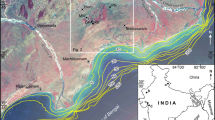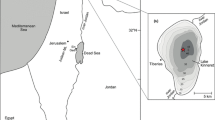Abstract
A 450 cm sediment core from Taperebal, in the mangrove region of northeastern Pará State in northern Brazil has been studied through pollen analysis in order to reconstruct mangrove development and dynamics and to infer relative sea-level (RSL) changes during the Holocene. Six AMS radiocarbon dates, which provide a somewhat limited age control with some uncertainties, suggest early and late Holocene deposits interrupted by a hiatus between them. A patchy vegetation of coastal Amazon rain forest, restinga, salt marsh and some mangrove, which was dominated by Avicennia, covered the study area during the early Holocene period. The occurrence of an early Avicennia dominated mangrove phase has not been reported so far from other sites in northern Brazil. During the mid Holocene mangroves mostly replaced the former coastal Amazon rain forest, restinga and some salt marsh vegetation, reflecting the rise in the RSL. Rhizophora trees expanded markedly and Avicennia became rare. In the sediment core there is apparently a gap between the depths of 115 and 85 cm (possibly starting between 5900 and 5750 b.p.). The deposits above 85 cm are of modern age and were probably deposited during the last decades. This gap can be explained by the lowering of the RSL as is shown for other northern Brazilian coastal sites. The deposition of sediments during the last decades suggests that the modern RSL is high compared to other periods in the Holocene. Pollen data from these deposits show that Rhizophora trees dominate the mangrove forests, also indicating a high RSL.




Similar content being viewed by others
References
Behling H (2001) Late quaternary environmental changes in the Lagoa da Curuça region (eastern Amazonia, Brazil) and evidence of Podocarpus in the Amazon lowland. Veg Hist Archaeobot 10:175–183
Behling H (2002) Impact of the Holocene sea-level changes in coastal, eastern and central Amazonia. Amazoniana 1/2:41–52
Behling H, da Costa ML (1997) Studies on Holocene tropical vegetation, mangrove and coast environments in the state of Maranhão, NE Brazil. Quatern South Amer Antarc Penins 10:93–118
Behling H, da Costa ML (2000) Holocene Environmental Changes from the Rio Curuá Record in the Caxiuaña Region, Eastern Amazon Basin. Quat Res 53:369–377
Behling H, da Costa ML (2001) Holocene vegetational and environmental changes from the Lago Crispin record in Northeasten Parà State, easten Amazonia. Rev Palaeobot Palynol 114:175–183
Behling H, Cohen MCL, Lara RJ (2001a) Studies on Holocene mangrove ecosystem dynamics of the Bragança peninsula in north-eastern Parà, Brazil. Palaeogeogr, Palaeoclimatol, Palaeoecol 167:225–242
Behling H, Keim G, Irion G, Junk W, Nunes de Mello J (2001b) Holocene environmental changes in the Central Amazon Basin inferred from Lago Calado (Brazil). Palaeogeogr, Palaeoclimatol, Palaeoecol 173:87–101
Behling H, Cohen MCL, Lara RJ (2004) Late Holocene mangrove dynamics of Marajó Island in Amazonia, northern Brazil. Veg Hist Archaebot 13:73–80
Blasco F, Saenger P, Janodet E (1996) Mangroves as indicators of coastal change. Catena 27:167–178
Chaves P, Bouchereau J-L (1999) Biodiversité et dynamique des peuplements ichtyiques de la mangrove de Guaratuba, Brésil. Oceanologica Acta 22:353–364
Cohen MCL (2003) Past and current mangrove dynamics on the Bragança peninsula, Northern Brazil. PhD thesis, University of Bremen, Germany
Cohen MCL, Lara RJ, Szlafsztein CF, Dittmar T (2003) Digital Elevation Model applied to Mangrove Coast Analysis, Amazon Region, Brazil. J Int Environ Creat 4:1–8
Cohen MCL, Souza Filho PWM, Lara RJ, Behling H, Angulo RJ (2004) A Model of Holocene mangrove development and relative sea-level changes on Bragança Peninsula (Northern Brazil). Wetlands Ecol Manag, in press
Colinvaux P, De Oliveira PE, Moreno Patiño JE (1999) Amazon pollen manual atlas, Manual e atlas palinolόgica da Amazonia. Harwood Academic Publishers
Faegri K, Iversen J (1989) Textbook of pollen analysis, 4th edn. Wiley, Chichester
Grimm EC (1987) CONISS: a FORTRAN 77 program for stratigraphically constrained cluster analysis by the method of incremental sum of squares. Comp Geosci 13:13–35
Grimm EC (1990) TILIA and TILIAGRAPH: PC spreadsheet and graphic software for pollen data. INQUA Subcommission on Data-Handling Methods. Newsletter 4:5–7
Kjerve B, Lacerda LD (1993) Mangroves of Brazil. In: Conservation and Sustainable Utilization of Mangrove Forests in Latin America and African regions. Part 1: Latin America. ITTO/ISME ProjectPD114/90(F), 245–272
Laegdsgaard P, Johnson C (2000) Why do juvenile fish utilise mangrove habitats? J Experiment Mari Biol Ecol 259:229–253
Lalli CM, Parsons TR (1993) Biological oceanography: an introduction. Butterworth Heinemann
Machado W, Silva-Filho EV, Oliveira RR, Lacerda LD (2002) Trace metal retention in mangrove ecosystems in Guanabara Bay, SE Brazil. Mar Poll Bull 44:1277–1280
Mathison SW, Chmura GL (1995) Utility of microforaminifera test linings in palynological preparations. Palynology 19:77–84
Menezes MPM (1997) Mécanisme de pollinisation du palétuvier, Rhizophora mangle, dans les mangroves en Amazonie, Brésil. Masters thesis, Université du Québec à Montréal, Canada
Roubik DW, Moreno JE (1991) Pollen and Spores of Barro Colorado Island. Missouri Botanical Garden, Saint-Louis, 36
Scholl DW, Stuiver A (1964) Recent submergence of southern Florida: a comparison with adjacent coasts and other eustatic data. Geolog Soc Amer Bull 78:437–454
Souza Filho PWM, El-Robrini M (1996) Morfologia, processos de sedimentação e litofácies dos ambientes morfo-sedimentares da planicie costeira bragantina, nordeste do Pará, Brasil. Genomos 4:1–16
Souza Filho PWM, Paradella WR (2002) Recognition of the main geobotanical features along the Bragança mangrove coast (Brazilian Amazon region) from Landsat TM and RADARSAT-1 data. Wetlands Ecol Manag 10:123–132
Tomlinson PB (1986) The botany of mangroves. Cambridge University Press, Cambridge
van de Plassche O (1986) Sea-level research: A manual for the collection and the evaluation of data, Geobooks, Norwich
Vannucci M (1988) Mangroves or deserts? Wastelands News:5–7
Walter H, Lieth H (1967) Klimadiagramm-weltatlas, Fischer, Jena
Woodroffe CD (1981) Mangrove swamps stratigraphy and Holocene transgression, Grand Cayman Island, West Indies, Mar Geol 41:271–294
Woodroffe CD (1982) Geomorphology and Development of Mangrove Swamps, Grand Cayman Island, West Indies. Bull Mar Sci 32:381–398
Acknowledgements
This work was been carried out within the framework of a Masters thesis from University of Wales, Swansea. Practical work and the writing of the Masters thesis were done at the Center for Marine Tropical Ecology (ZMT) in Bremen. The second supervisor P. Dyrynda is gratefully thanked. Members of the Center for Tropical Marine Ecology and Laboratório de Ciências Ambientais are thanked for their support. The first author acknowledges the help of U. Mehlig during the fieldwork and in the taking of digital photographs of the core. A. Kappel is thanked for constructive comments and logistic assistance during this work. The authors thank the reviewers L. Dupont and A-M. Lezine for constructive comments on the manuscript. This study was carried out as a part of the Brazilian-German Cooperation Project MADAM. The fieldwork and radiocarbon dating were financed by the Brazilian National Research Council (CNPq) and the German Ministry for Education and Research (BMBF) under the code 03F0154A
Author information
Authors and Affiliations
Corresponding author
Rights and permissions
About this article
Cite this article
Vedel, V., Behling, H., Cohen, M. et al. Holocene mangrove dynamics and sea-level changes in northern Brazil, inferences from the Taperebal core in northeastern Pará State. Veget Hist Archaeobot 15, 115–123 (2006). https://doi.org/10.1007/s00334-005-0023-9
Received:
Accepted:
Published:
Issue Date:
DOI: https://doi.org/10.1007/s00334-005-0023-9




